Introduction
The concept of building a Minimum Viable Product (MVP) is a fundamental strategy for startups looking to make an impact in the market. An MVP is a stripped-down version of a product that allows entrepreneurs to gauge consumer interest and collect valuable feedback while minimizing resources. The success stories of companies like inDrive demonstrate the potential impact of an MVP in driving rapid growth and expansion.
However, it's crucial for entrepreneurs to avoid being misled by their own assumptions and conduct thorough market research to validate their business idea. MVP development is not just about building a product; it's about testing a business hypothesis and iterating based on user feedback. This approach has been proven to save time, reduce costs, and align the final product with market demands.
In this article, we will explore the steps to building an MVP, the importance of market research, defining the target audience and problem statement, listing essential features, and the factors influencing the cost of building an MVP. We will also discuss the development, hosting, and marketing costs associated with an MVP project, as well as best practices for reducing MVP development costs. By following these guidelines, entrepreneurs can lay the foundation for a successful MVP that meets market needs and drives business growth.
Purpose of Building an MVP
The concept of a Minimum Viable Product (MVP) is a cornerstone in modern entrepreneurial strategy, particularly for startups looking to make their mark. An MVP is the most pared-down version of a product that can still be released to early adopters and the market. This approach serves a dual purpose: it allows for the gauging of consumer interest and collects valuable feedback with the least amount of expended resources.
Entrepreneurs are often faced with the pivotal question: 'Are we offering a solution to a pressing problem or merely a commodity?' Understanding the distinction is vital. A solution addresses a specific issue faced by potential users, while a commodity adds value to users' lives but isn't necessarily solving a problem.
This discernment can shape the development and positioning of an MVP.
Real-world success stories, such as that of inDrive, highlight the potential impact of an MVP. The company, during its formative years between 2016 and 2020, witnessed rapid growth and expansion into new markets after recognizing the strength of its business idea through its MVP. It's an attestation to the power of starting small and thinking big.
However, it's crucial for entrepreneurs to avoid being misled by their own assumptions about what constitutes a significant problem. What might seem like a critical issue from one perspective may not resonate with a broader audience, whose challenges and needs can differ greatly. Thus, the development of an MVP must be preceded by thorough market research and validation of the business idea.
In essence, MVP development is not just about building a product; it's about testing a business hypothesis and iterating based on user feedback. It's a strategy that has been proven to save time, reduce costs, and, most importantly, align the final product more closely with market demands.
Steps to Building a Minimum Viable Product
Entrepreneurs embarking on the journey of MVP software development must navigate several crucial steps to ensure their product effectively reaches the market. Initially, it's vital to determine whether your offering is a problem-solving solution or a convenience commodity. This foundational understanding shapes your approach and the MVP's design, ensuring it addresses real user needs and stands out in the marketplace.
Once this is established, a lean version of the product with just enough features to entice early adopters should be launched. This strategy is exemplified by 'The Barcode,' a mobile application for the hospitality industry that successfully connected bars, pubs, and clubs with new patrons using innovative offers. The application's development was iterative, allowing for continuous enhancements based on user feedback.
Rather than an all-encompassing product, the focus was on creating a user-centric MVP that provided real value in its compact form.
Moreover, it's essential to categorize development tasks into manageable segments, identifying which are straightforward and enjoyable versus those that are complex and less engaging. This approach aids developers in efficiently allocating their resources and maintaining momentum throughout the development process.
In the realm of AI startups, for example, founders in the Nordics and Baltics have leveraged their deep understanding of specific workflows and user behaviors to create AI-centric products that solve distinct problems, a principle that broadly applies to MVP development.
As the MVP takes shape, it's the real-time customer feedback that informs the subsequent iterations, ensuring that the evolving product aligns with customer pain points and expectations. By rigorously testing a core set of features, entrepreneurs can gauge the product's usefulness and readiness for the market, a step that is vital for a successful transition to a fully-fledged application.
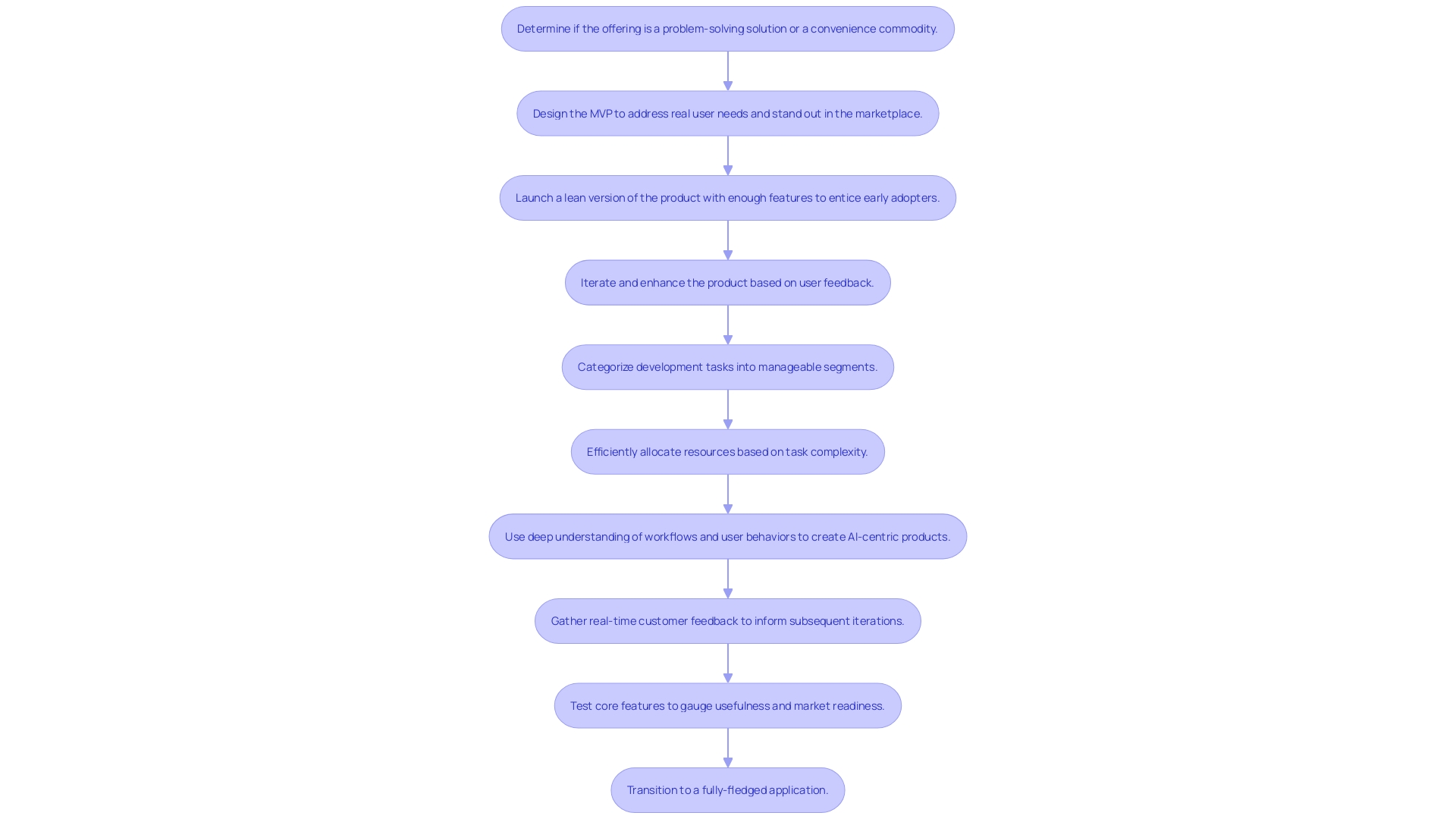
Conduct Market Research
Embracing market research is akin to deploying a compass before setting sail on the vast ocean of software development. It unveils critical insights into the target audience's desires, competitor activities, and untapped niches, offering a lens to view the demands and preferences of potential users. This strategic reconnaissance is not merely about confirming the existence of a demand; it's a quest to pinpoint opportunities for uniqueness that will distinguish the MVP from the multitude.
For example, JetBrains, a renowned software development company, leverages its Market Research & Analytics team to dissect the developer ecosystem, producing data-driven insights that shape product development. They don't limit themselves to developer surveys but extend their expertise to UX, cognitive studies, and business research, ensuring a holistic approach to understanding market dynamics.
In light of current trends, market research is becoming increasingly sophisticated. With the impending need for automated quality controls and detailed software artifact histories, companies must deepen their knowledge of how code evolves within their systems. This knowledge helps not only in identifying and rectifying issues quickly but also in understanding the broader context of software deployment and usage.
Furthermore, as AI continues to revolutionize software creation, reports like 'The New Developer' research by Pluralsight caution against overlooking the human aspect of technology adoption, emphasizing the importance of aligning Ai's trajectory with developers' skills and motivations.
Ultimately, the question "Are we a solution or a commodity?" sits at the heart of market research. It compels businesses to confront the reality of their offerings.
The aim is not to be swayed by biases or assumptions, but rather to objectively determine whether the product solves a significant problem or simply enhances convenience. The intersection of customer and UX research, as highlighted by industry experts, is where true understanding crystallizes, guiding not only product development but marketing and customer support strategies as well. By adopting a dual-phase approach of exploration and exploitation, as suggested by research-oriented companies, one can swiftly navigate through a plethora of ideas, eventually crystallizing the most viable solution into a robust product.
Define Your Target Audience and Problem Statement
Crafting an MVP begins with a deep dive into the specific needs and preferences of the intended user base. For instance, consider the case of developing an online marketplace for fresh, organic produce. A thorough market analysis must precede any feature selection, delving into the primary hurdles consumers face when seeking out organic fruits and vegetables.
What do the users prioritize? Freshness, diversity, and certified organic goods are likely at the top of their list. The MVP should encapsulate these core requirements, offering a streamlined catalogue, intuitive search and filter functions, and reliable delivery options.
The design should prioritize user experience, ensuring that the platform is not only functional but also accessible and user-friendly. This approach echoes the sentiment that a product must be more than just an attractive option—it should present a solution to a genuine problem, one that resonates with users beyond the bounds of our individual perspectives and experiences.
List the Product’s Essential Features
The essence of MVP development lies in isolating the indispensable functionalities that address the core needs of your target audience. Entrepreneurs stand to gain by sidestepping non-essential features, thereby simplifying and accelerating the development journey. Visualizing the end product through sketches or notes can help crystallize the focus on these critical features.
As illustrated by the aspiring Crypto Use Pay, a payment gateway for cryptocurrencies, the ability to articulate your product's purpose succinctly after listing its features is a testament to a well-defined MVP. The introspection on whether your offering is a solution to a pressing problem or a valuable convenience can make a significant difference in this process. This strategic approach ensures that the initial product version is not only viable but also optimized for effective problem-solving, providing a solid foundation for future iterations and enhancements.
Build Your MVP
Embarking on MVP software development is a decisive moment for any startup, as it shapes the future direction of the product. This critical phase must pivot around the key principle of delivering a functional prototype that exemplifies the core attributes of the product. Through a streamlined approach, focusing on simplicity and essential functionality, the MVP serves as an early model that offers a glimpse into the user experience and the product's potential impact.
A shining example of this approach is the launch of "The Barcode," a mobile application tailored for the nightlife industry, aimed at connecting bars, clubs, and pubs with their potential clientele. The development team, acting as both the design and developmental cortex, transformed an entrepreneurial concept into reality. Their journey didn't halt at the MVP stage; it evolved through continuous iterations, enhancing the application based on user feedback and market demands.
This iterative process is not just a choice but a necessity, underscored by the harsh statistics that over two-thirds of startups fail to return a positive outcome to investors, as highlighted by Harvard Business Review. The common thread among these failures is often a lack of proper product validation. CBInsights identifies the inability to secure adequate funds and the absence of market demand as the top reasons for startup failures.
Both of these pitfalls can be navigated effectively with a well-conceived MVP that validates the product-market fit early on.
Indeed, the question of whether a product is a solution to a significant problem or merely a convenience is paramount. It requires a deep understanding of the market and the customers' needs, often challenging our preconceived notions. What may seem like a critical issue from one perspective could be trivial to the target audience.
The MVP is the tool that provides real-world answers to these vital questions.
As we delve into the creation of an MVP, it's imperative to remember that what we are truly crafting is not just a rudimentary version of a product, but a strategic tool that lays the foundation for future growth, adaptation, and success.
Factors Influencing the Cost of Building an MVP
Determining the investment required for MVP software development is a multifaceted process, as multiple variables come into play. Let’s delve into the core factors that dictate the financial scope of launching a Minimum Viable Product.
- Understanding the Product's Purpose: Clear identification of the product's goal is paramount. It's not just about listing features, but about defining the purpose of your MVP in a succinct sentence. This initial clarity helps in shaping a product with the necessary functionality to deliver a single improved outcome to users, emphasizing the 'minimum' in MVP.
- Prioritizing Features: A disciplined approach to feature selection is critical. Every feature must be scrutinized and only those absolutely essential to the core value proposition should be included. This focus not only streamlines the development process but aligns with user expectations, optimizing both time and resources.
- Development Phases: Understanding that software development is cyclical, from requirements analysis, design, implementation, to testing, helps in allocating budget effectively. Each phase has its complexities and costs, which contribute to the overall expense of creating an MVP.
- Mobile App Development Trends: With mobile apps being integral to modern life and a predicted revenue generation of over $613 billion by 2025, it’s vital to understand the market trends and user preferences. This insight can guide the development process, ensuring the MVP aligns with current demands and is set for scalability.
- Market Validation: MVPs serve as a litmus test for market validation, offering essential feedback for iteration. This iterative process is a cost-effective strategy to refine the product, with the aim of solving a genuine problem or enhancing user convenience.
- Technology and Complexity: The type of web app, whether a personal blog or a complex business solution, impacts the cost. Like a dream house, the 'size, features, and location' of your digital product, metaphorically speaking, will determine the final budget.
- Industry Insights: Leveraging the expertise of MVP development companies can offer guidance on cost reduction and customer engagement strategies. Companies like Appinventiv utilize Lean Startup Methodology to validate product ideas and iterate upon user feedback before full-scale development.
In essence, a ruthless focus on execution, clear definition of purpose, and judicious feature selection are paramount in estimating the cost of building an MVP. Coupled with an understanding of the software development lifecycle, market trends, and leveraging external expertise, entrepreneurs can navigate the cost landscape of MVP development with greater precision.
Development Costs
Calculating the cost of developing a Minimum Viable Product (MVP) can be akin to budgeting for a custom-built home, where the final figure is influenced by the product's intricacy, the technology stack selected, and the proficiency of the developers involved. The MVP approach focuses on integrating only the most crucial features necessary to deploy the product and gather user feedback, thereby optimizing development expenditures.
The process commences with a meticulous feature analysis, prioritization, and the elimination of superfluous functionalities. By visualizing the end product through sketches and clearly articulated objectives, teams can stay aligned and avoid over-engineering. Early adopters of your MVP should encounter a coherent, purpose-driven product capable of solving their fundamental problems without the distraction of non-essential features.
A comprehensive guide to mobile app development costs underscores the volatility of pricing, which can span from $10,000 to upwards of $350,000. This variability is mirrored in the broader landscape of software development, where the price of crafting web applications is subject to the scale, complexity, and technological demands of the project.
In the realm of software engineering, coding is just one facet of a multifaceted discipline that involves aligning with business goals, authenticating concepts, and designing user experiences. Recognizing this, the prudent path involves a thorough validation of ideas before committing substantial resources to development.
The Financial Accounting Standards Board's recent proposal, scaling back regulations from the 1980s and 1990s, reflects the evolving recognition of software's pivotal role across industries. The proposed accounting changes aim to simplify how companies report and manage their software development costs, particularly for internal-use software and hosting services.
As the software development landscape continues to expand, with the global community of developers reaching approximately 13.4 million in 2023, it's evident that an array of factors—from the choice of programming language to the phasing of costs—can significantly impact productivity and financial planning in the creation of digital solutions.
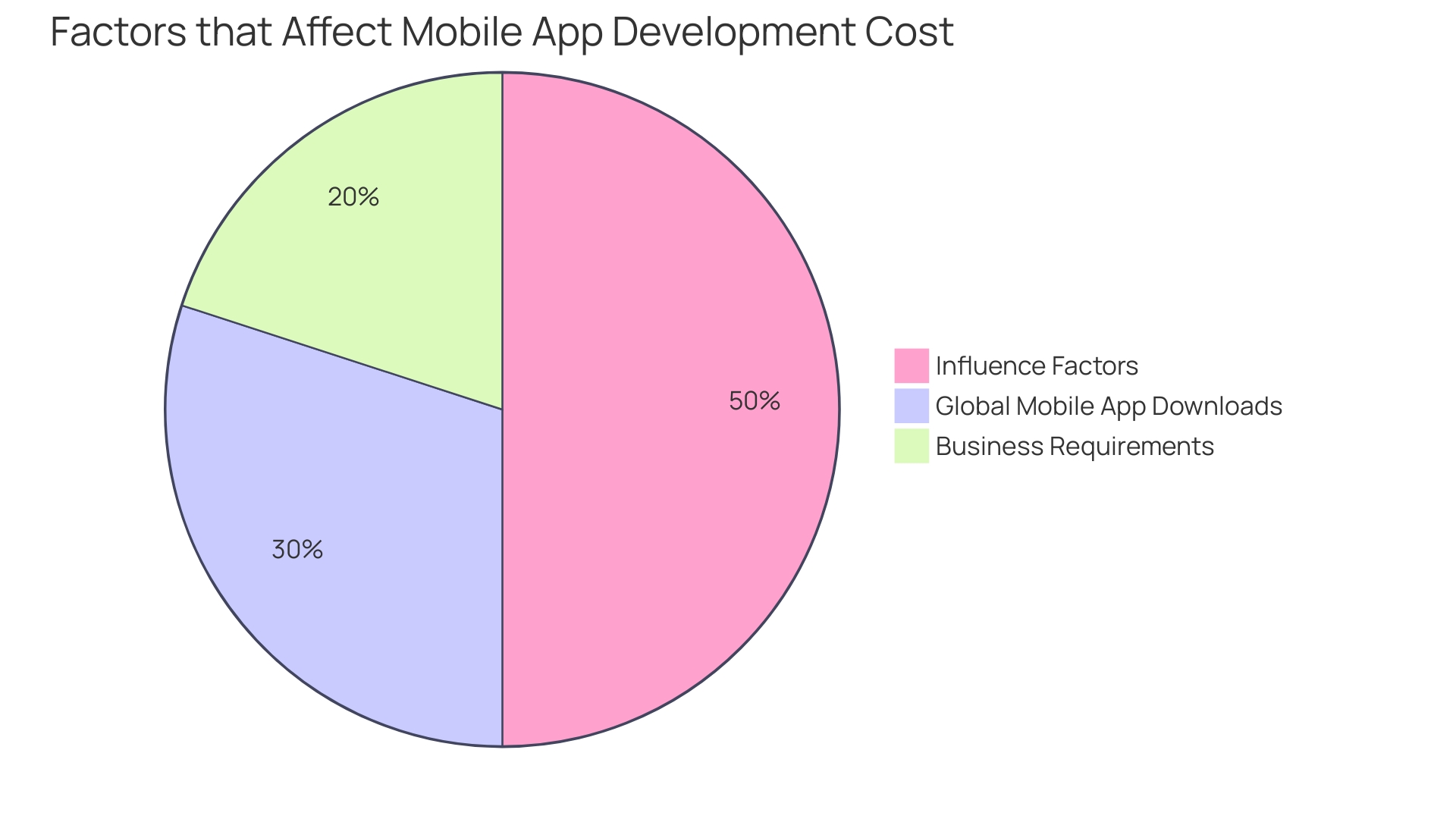
Hosting Costs
When considering hosting an MVP, it's essential to factor in the cost implications that come with various hosting services. These services often come with a range of pricing options, influenced by the scale of your application, the data capacity it requires, and the bandwidth necessary to ensure a smooth user experience. For instance, web development agencies catering to small and medium-sized clients may prioritize robust yet affordable hosting solutions that align with specific operational needs.
This approach reflects the broader trend in the tech industry, where the democratization of development has led to a diverse array of hosting solutions, suitable for different types of web apps—from personal blogs to full-scale corporate websites.
Recent market trends underscore the importance of cost-effective development strategies. The global tech sector has experienced significant growth, with over 13.4 million professional developers worldwide by 2023. This growth is mirrored in the evolving landscape of web app development, where the cost can vary greatly depending on the app's purpose, whether it's a simple landing page or a complex, feature-rich platform.
For example, a personal website may require minimal investment compared to a corporate site designed to showcase a wide array of products and services.
In line with this, the hosting costs for an MVP must be carefully considered to ensure they align with the overarching goals of the product. A study highlighted that the cost of developing a mobile app could range from $10,000 to upwards of $350,000, influenced by various factors, one of which is the hosting environment. Selecting the right hosting platform is a crucial decision that can impact the scalability and performance of your MVP, and thus, the success of your project.
Hosting costs are not just monetary; they're about making strategic decisions that support the growth and evolution of your MVP. It's about finding a balance between affordability and the capacity to scale as user demand increases. As we've seen with companies like Arm Holdings, which achieved a valuation of over $55 billion after a successful IPO, the right technological decisions can position a company for unprecedented growth and success.
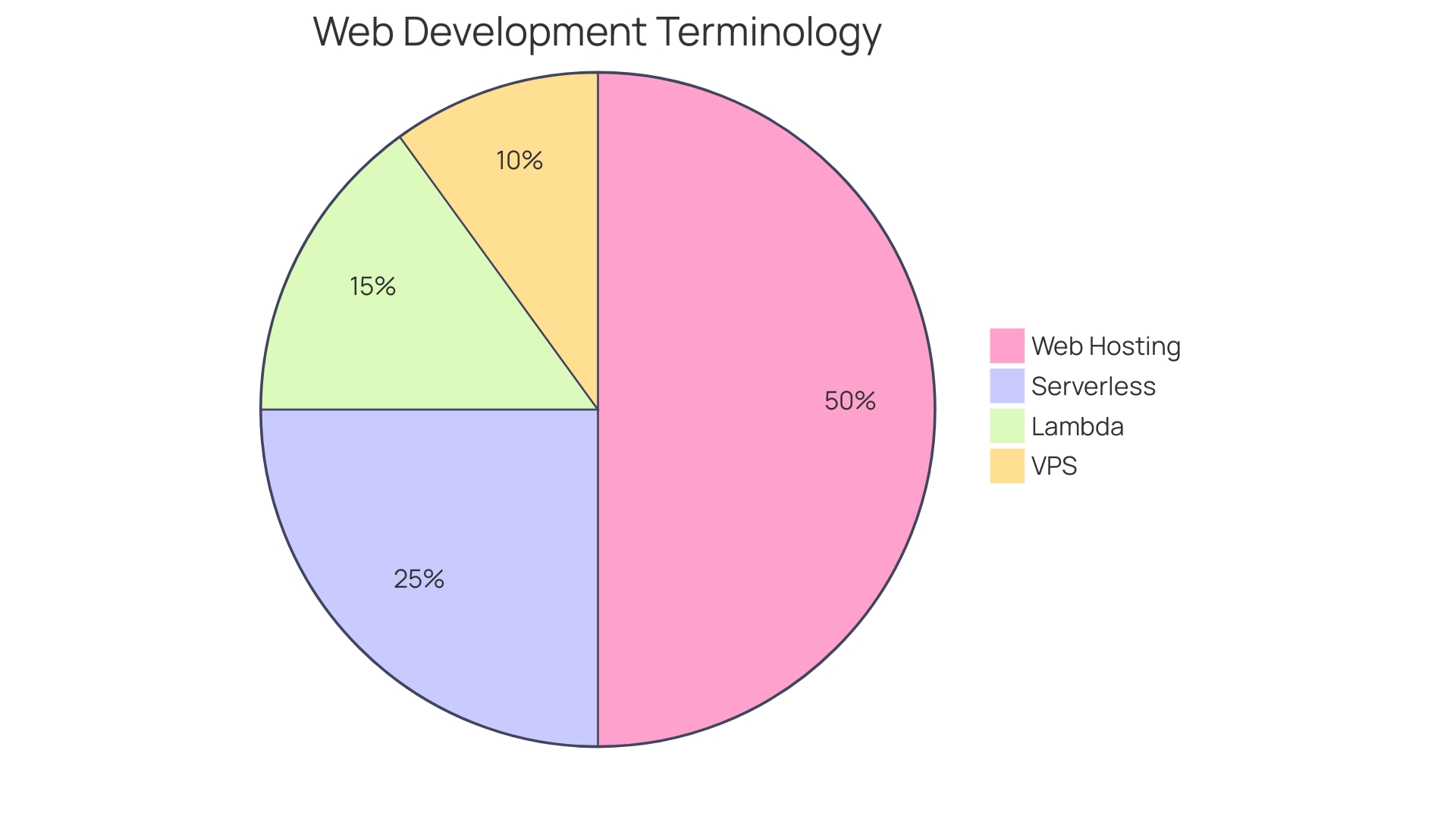
Marketing Costs
When crafting a Minimum Viable Product (MVP), it's essential to target early adopters effectively, which often necessitates carefully planned marketing initiatives. Such efforts are not merely about creating visibility but also about validating whether your MVP truly addresses a significant pain point or serves as a convenient asset in the lives of users. By considering the MVP as a solution to a particular problem, one can tailor marketing strategies to resonate with the target audience's needs.
For instance, implementing digital marketing campaigns that highlight the problem-solving nature of the MVP can lead to a more effective acquisition of early adopters. Social media advertising should focus on engaging potential users by showcasing the MVP's utility and soliciting their feedback. This approach not only drives interest but also fosters a community around the product, which is vital for iterative development.
Content creation plays a pivotal role here, as it helps articulate the MVP's value proposition in a way that speaks directly to the user's challenges, thus distinguishing the MVP from being seen as just another commodity.
As the software development landscape evolves, staying abreast of technological trends like generative AI can offer fresh paradigms for creating compelling marketing content. This could include leveraging AI to generate personalized copy or dynamic visuals that capture the unique selling points of the MVP. Furthermore, partnering with a reputable MVP development company can also provide a wealth of expertise in fine-tuning the product based on user feedback, thereby enhancing the overall marketing message.
Ultimately, the cost of marketing an MVP is an investment in its refinement and success. Aligning marketing efforts with the core functionality and potential of the MVP ensures that early adopters are not just customers but collaborators in the product's journey from a basic prototype to a fully-fledged solution.

Estimating MVP Development Costs
Calculating the cost of developing a Minimum Viable Product (MVP) is a multifaceted process that hinges on several critical considerations. A fundamental step is to distinguish whether the MVP is serving as a solution to a pressing problem or merely acting as a convenience-enhancing commodity. This distinction is pivotal, as it shapes the scope and complexity of the MVP.
For instance, if an entrepreneur owns multiple businesses and seeks an application to streamline group accounting practices, this MVP would address a specific problem, potentially requiring intricate features tailored to the entrepreneur's unique needs. The understanding of MVP as a solution or a commodity sets the stage for the development process, influencing the technical requirements and, consequently, the cost.
Supporting this approach, Harvard Business Review notes that a lack of market need is a primary reason for startup failures. Thus, aligning the MVP with market demands is crucial. A well-conceived MVP enables entrepreneurs to test their product hypothesis with minimal resources, gather valuable user feedback, and validate the product concept before scaling up.
The process of MVP development, akin to constructing a web application, involves factors such as the complexity of features and user interface design. The Mythical Man-Month highlights the intricacies of software engineering, emphasizing that the development cost will vary significantly based on the project's requirements. It's not just about coding; it's about creating a cohesive product that resonates with users and fulfills a need.
Therefore, engaging with seasoned developers for a comprehensive analysis of project requirements is advisable to obtain a precise cost estimation. This strategic evaluation ensures the MVP is not only cost-effective but also effectively positioned to meet user expectations and market needs, bolstering the chances of a positive return on investment.
Platform and Team Considerations
For entrepreneurs embarking on MVP software development, it is imperative to meticulously select a development platform and form a team of proficient developers. The platform's ability to scale should align with future business growth and the team must possess the necessary expertise to rapidly evolve the MVP based on user feedback. Market research indicates that 42% of new SaaS products fail due to a lack of market need; therefore, it is essential to validate the problem your MVP intends to solve, ensuring it delivers a core value proposition and addresses actual market demands.
Begin by documenting every feature you plan to include, prioritizing only the essential functionalities that define the MVP. Visualizing your MVP through sketches can provide clarity on what you're building. After listing all the features, you should be able to articulate its purpose succinctly.
Furthermore, a comprehensive analysis of different MVP types and their corresponding market examples reveals that starting with a basic yet functional version of your product can attract early adopters. This approach enables you to gauge customer response, usefulness, and whether it effectively resolves pain points.
When it comes to team selection, it's crucial to shortlist companies that match your criteria and to inquire about their technical stack, work processes, management experience, and portfolio. Ask targeted questions to understand their capabilities and how they align with your project’s needs, such as their experience with similar projects, access to project files during development, pricing, and the scope of services provided.
As you embark on your MVP journey, remember that you are not just creating a commodity; you are providing a solution to a significant problem. Understanding the distinction is vital, and it is critical to avoid misconceptions about the importance of the problem you are solving, which may vary based on different perspectives. With a well-researched, purposeful MVP and the right development team, you can lay the foundation for a successful product that meets and exceeds market expectations.
Geographical and Location Factors
The cost of developing a Minimum Viable Product (MVP) can be heavily influenced by geographical location. With global mobile app revenue projected to reach over $613 billion by 2025, startups and established companies alike are keenly aware of the importance of cost-effective development. Offshore development has become a strategic approach to managing costs, allowing access to a vast pool of global talent and potentially lower hourly rates for software development services.
For instance, tapping into the talent pools of countries like India, Ukraine, or Vietnam can lead to significant savings when compared to the costs associated with local developers in the United States or Western Europe.
As of 2023, the worldwide developer community has grown to approximately 13.4 million professionals, indicating the extensive availability of technical expertise across different regions. Embracing offshore development can not only reduce project expenses but also enable companies to invest more resources into other vital areas of their business.
Moreover, the software engineering landscape has evolved beyond mere coding. It now encompasses a deep understanding of business needs, idea validation, and user experience design. This broadened scope underscores the need for a strategic approach in selecting the right development team that aligns with the project's requirements, whether it involves web development, mobile app development, or advanced technologies like blockchain or artificial intelligence.
In line with this, careful planning and prioritization of features are critical. As advised by industry experts, it is essential to focus on including only the necessary functionalities in an MVP, to address real problems that provide unique value to customers. This focused approach not only streamlines development but also ensures that resources are allocated effectively, further optimizing the overall cost.
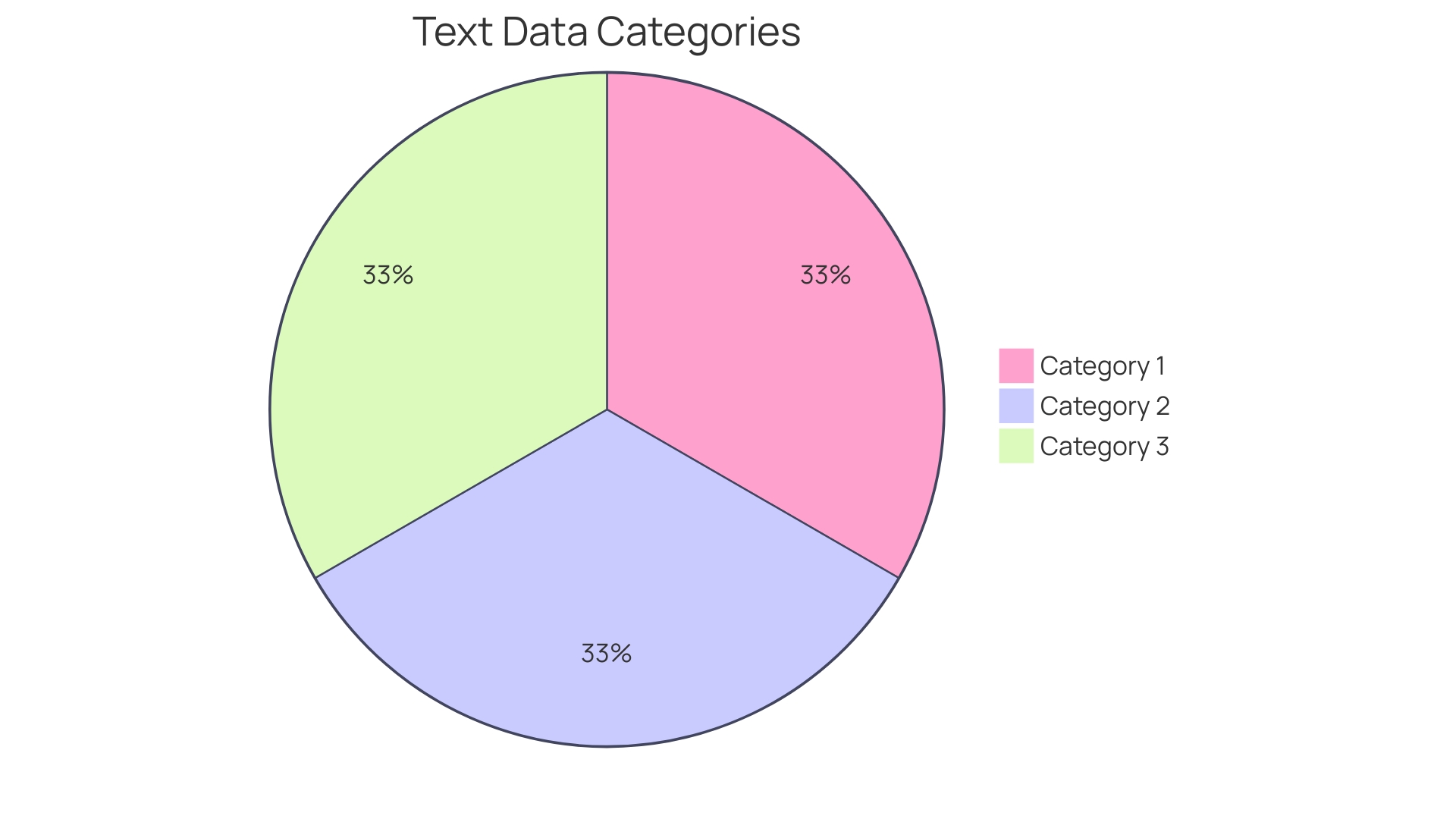
Example Cost Breakdown for an MVP Project
When dissecting the financial commitments of a software development project, it's essential to recognize that a one-size-fits-all price tag is a myth. The investment needed is shaped by myriad factors, from the complexity of the product to the depth of market research. To crystallize the idea, let's delve into the typical cost categories:
-
Development Costs: Custom software development in 2024 can vary broadly, with industry consensus suggesting a spectrum from $70,000 to $250,000. The variability hinges on the project's scope, technology stack, and the team's expertise. Specifically, MVP development allows businesses to allocate funds judiciously, focusing on the essential features that meet core user needs and enable early market entry.
-
Hosting Costs: The digital residence for your software, web hosting, can impact your budget. With options ranging from shared hosting to dedicated servers, expenses can vary from $5.99 to $24.99 per month at providers like GoDaddy. The chosen hosting package should align with your business requirements and ensure reliable website performance.
-
Marketing Costs: As pivotal as development and hosting are, marketing is the engine that propels your product into the market. While it's challenging to pinpoint exact costs without a tailored strategy, marketing expenditures should reflect the product's niche, target audience, and desired reach.
Remember, these figures are merely a snapshot; true cost estimation demands an in-depth analysis of your business objectives, project specifics, and the competitive landscape. It's the nuanced understanding of whether you're offering a solution to a pressing problem or a commodity that enhances convenience that will guide your financial planning. The objective is not just to build software but to create a vehicle that delivers value with each release, thus justifying the investment and securing a foothold in the market.
Best Practices for Reducing MVP Development Costs
To streamline MVP software development and economize expenses, entrepreneurs should embrace the following strategies: First, it's crucial to delineate your MVP's essential features, excluding extraneous complexities. This can be best achieved by drafting a prioritized feature list, ensuring only vital functionalities that reflect the product's core purpose are included. Visualization through sketches can aid in this process, offering a clear blueprint of what is to be built, while keeping it uncomplicated with just a handful of functionalities.
Secondly, tapping into existing technologies and frameworks can substantially curtail the time required for development. As seen with the Ford Foundation's initiative to enhance their digital engagement using a new video accessibility plugin for WordPress, leveraging existing solutions can lead to efficient and effective product enhancements.
Adopting an agile development methodology is another best practice, as it fosters rapid iterations and immediate user feedback. This approach aligns with the experience of numerous startups, where an agile mindset has facilitated the testing of key assumptions and expedited the journey towards a fully functional product.
Outsourcing certain development tasks can also be a wise move to manage costs without compromising on quality. This method has proven successful for the Barcode app, where outsourcing the design and development components allowed for a focus on continuous improvement and value delivery to its users.
Finally, it's imperative to engage a small user group for product testing and validation before considering a broader scale. This strategy echoes the sentiment of industry experts who emphasize the necessity of being a solution rather than just a commodity. The initial user feedback becomes a critical indicator of whether to further invest in the product or pivot to a new direction.
In conclusion, these best practices are rooted in real-world examples and expert insights, highlighting the significance of clarity, efficiency, and user-centricity in MVP software development.
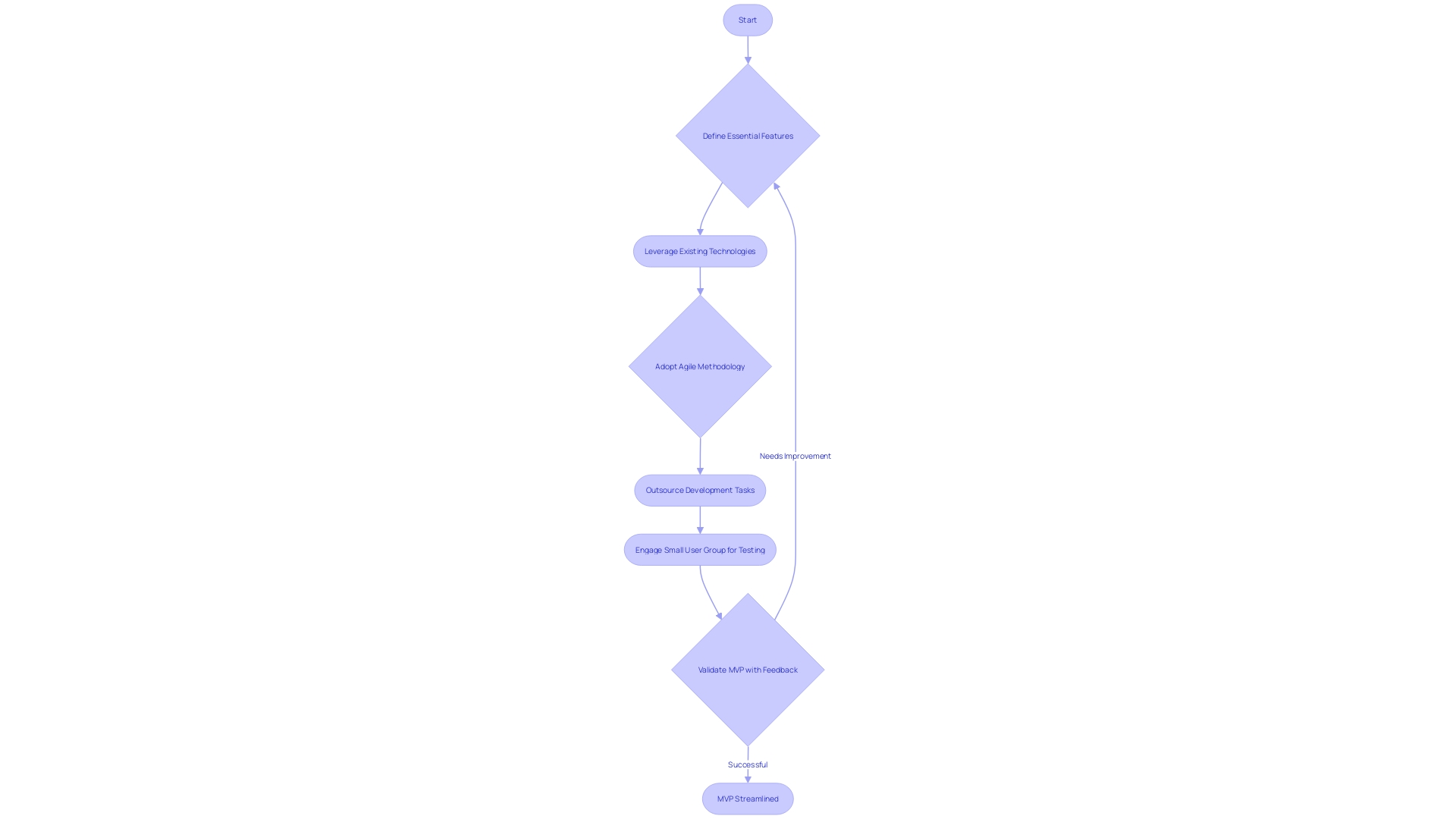
Conclusion
Building an MVP is crucial for startups looking to make an impact in the market. It allows entrepreneurs to gauge consumer interest and collect valuable feedback while minimizing resources. Thorough market research and validation of the business idea are essential to save time, reduce costs, and align the product with market demands.
The steps to building an MVP include determining the nature of the offering, conducting market research, defining the target audience and problem statement, listing essential features, and building based on user feedback.
Factors influencing the cost of building an MVP include understanding the product's purpose, prioritizing features, categorizing development tasks, considering mobile app development trends, market validation, technology and complexity, and leveraging industry insights.
Carefully considering hosting costs and selecting the right hosting platform is essential for reliable website performance. Effective marketing strategies are crucial for targeting early adopters and validating the MVP's value proposition.
To reduce MVP development costs, entrepreneurs should prioritize essential features, leverage existing technologies, adopt an agile development methodology, outsource certain tasks, and engage a small user group for testing and validation.
In conclusion, a strategic approach aligned with market demands and user needs is key to building a successful MVP. Following best practices, entrepreneurs can streamline development, reduce costs, and create a product that meets and exceeds market expectations.





